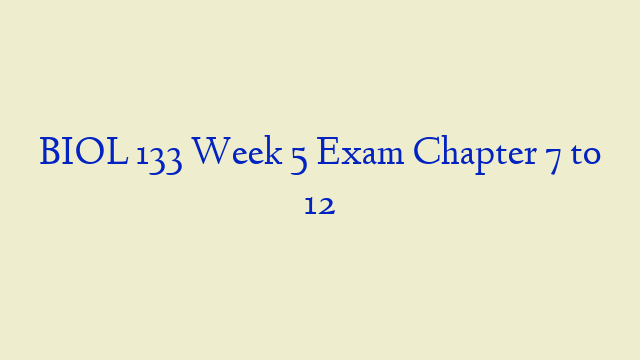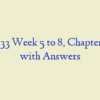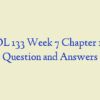Description
Chapter 7- Week 5 Study Questions with Answers
10.0/ 10.0 Points
- What is not a good biological oxidizing agent?
- Molecules generated from butter will enter aerobic cellular respiration at
- In gluconeogenesis, organisms use ATP to make glucose, then in cellular respiration they break down the glucose again to get energy. Why not just store the ATP? (Select all that apply.)
- Removal of NH3 is best described as ____________ .
- What area is not involved with pumping protons to the intermembrane space?
- What vitamin derivative accepts hydrogen for complex I during ETC?
- When has glucose been broken down from its original 6 carbon molecule to 6 molecules of carbon dioxide?
- Assuming 2 ATPs are produced per FADH2, how many ATPs will be produced in oxidative phosphorylation per glucose molecule?
- NADH and FADH2 are products of
- ____________ carbon dioxide molecules are given off during three turns of the Krebs cycle?
Chapter 8 Week 5 Study Questions
10.0/ 10.0 Points
- Organic molecules are made in the _______________ .
- Protons from electron transport will amass in the
- P700 first transfers an electron through chlorophyll and a bound
- If rubisco does not function properly, what process would be affected?
- What is the flow of energy in order from source to end?
- What statement shows the relationship among chloroplasts and mitochondria?
- The light independent reactions are important because they
- ____________ membranes can be found in a chloroplasts.
- Light-dependent reactions build NADPH and oxygen by ________________ .
- What properties are expressed by wavelengths? Select all that apply.
Chapter 9 Week 6 Study Questions
10.0/ 10.0 Points
- Protein phosphorylating enzymes help regulated gene expression by
- ________ is the substrate for adenylyl cylcase.
- Diacylglycerol and inositol triphosphate are released from phosphatidylinositol biphosphate by ________ .
- Since plants have rigid cell walls formed from cellulose, transfer of information and materials between cells is prohibited.
- What describes transcription factors?
- A common theme in many pathways is a cascade of similar enzymes acting on each other in sequence. For instance, MAP kinase kinase kinase adds a phosphate to MAP kinase kinase, which adds phosphate to MAP kinase, which adds phosphate to another substrate. What is the benefit of using a cascade of enzymes?
- If calcium levels are low, cAMP activity increases which leads to synthesis and release of parathyroid hormone. cAMP acts as a(n)
- Teeth can have a biofilm formed on the surface. Cell signaling will
- Cell surface receptors have three domains with different roles. Match each role to the domain that is responsible.
- Vibrio fischeri are bioluminescent when the population reaches a certain size. This is an example of
Chapter 10 Week 7 Study Questions
10.0/ 10.0 Points
- Place the order of events in chromosome packaging from beginning to end.
- Damaged DNA can potentially be repaired during which checkpoint. Select all that apply.
- A large cell will be initiated to divide because
- A cell’s entire amount of hereditary information is the
- Which molecule initiates the halt of the cycle when damaged DNA is detected in G1?
- In nature, there is an exception to every rule. Of the species below, which one has a very unusual genome that violates the “rule”?
- If there are 8 centromeres in metaphase, how many centromeres will be present in anaphase?
- If a researcher looks at a cell and notices a straight line of sister chromatids, which phase are they viewing?
- In which type of human cell(s) would 46 chromosomes be located? Select all that apply.
- When the p53 gene is damaged, which event may happen?
Chapter 11 Week 7 Study Questions
7.67/ 10.0 Points
- Meiosis and sexual reproduction increase diversity because
- A newly-discovered butterfly species has a chromosome number of n=7. Match the total number of chromosomes in each type of cell.
- Which describes the relationship between gametes and spores?
- Which event is similar between prophase I and prophase? Select all that apply.
- What is an advantage of asexual reproduction? Select all that apply.
- A nuclear envelope does not usually form around each set of chromosomes in the haploid daughter cells in _________.
- A few organisms have evolved to use mostly asexual reproduction. What must be true about these?
- How does metaphase in meiosis I and meiosis II differ?
- A large family has a history of multiple aneuploid diseases such as Down Syndrome, trisomy-18 and Klinefelter Syndrome (XXY). The propensity to defects seems to be inherited, but the gene responsible is unknown. What types of candidate genes would be most likely to lead to aneuploidy if they were mutated?
- Most organisms on earth spend large amounts of energy reproducing sexually, instead of using a more efficient method of asexual reproduction. Finding and competing for mates, meiosis and gamete production, and the complexities of fertilization could all be avoided if asexual reproduction was sufficient. Why isn’t it?
Chapter 12 Week 8 Study Questions
10.0/ 10.0 Points
- What statement describes X-linked traits? Select all that apply.
- Sickle cell anemia is a recessive trait. A cross between two heterozygotes would produce what phenotypic ratio?
- Marfan syndrome is a dominant trait. A cross between a homozygous dominant and a heterozygote would produce what phenotypic ratio?
- If a cross for widow’s peak was conducted between a homozygous dominant and a heterozygote, it is expected that all organisms of the offspring will have widow’s peak. Even though all have the widow’s peak, they can _________.
- A and Z are independent events. The probability that A occurs is ¼. The probability that Z occurs is ¼. What is the probability that both will occur?
- If genes are completely linked, all the offspring will be _________.
- Low pitched male voices (RR) and a high pitched male voice (rr). Heterozygotes have a baritone voice. This is an example of _________.
- The allele for widows peak (H) is dominant for the allele for no widows peak (h). At a different gene locus, the allele for hitchhikers thumb (D) is dominant to the allele for non-hitchhikers thumb (d). A man is heterozygote for the traits and marries a woman who has no widows peak and is heterozygote for hitchhikers thumb. What is the man’s genotype?
- Determine what statements describe Huntington’s disease? Select all that apply.
- In a monohybrid cross from heterozygous parents, of the offspring would be what genotypes? Select all that apply.



